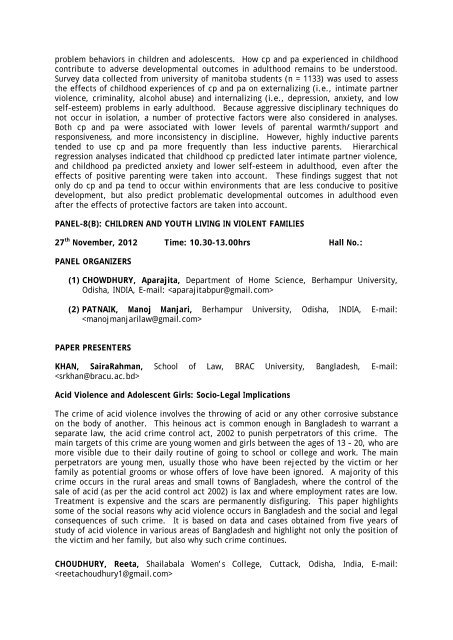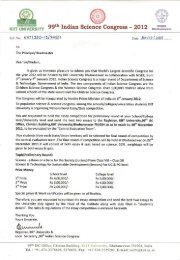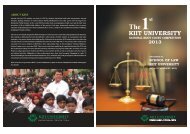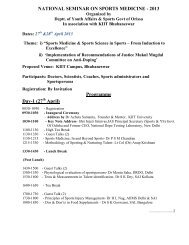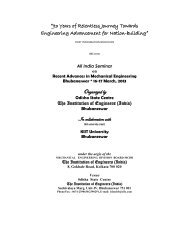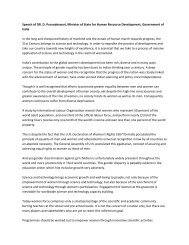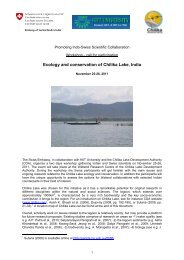PANEL ORGAN - KIIT University
PANEL ORGAN - KIIT University
PANEL ORGAN - KIIT University
Create successful ePaper yourself
Turn your PDF publications into a flip-book with our unique Google optimized e-Paper software.
problem behaviors in children and adolescents. How cp and pa experienced in childhood<br />
contribute to adverse developmental outcomes in adulthood remains to be understood.<br />
Survey data collected from university of manitoba students (n = 1133) was used to assess<br />
the effects of childhood experiences of cp and pa on externalizing (i.e., intimate partner<br />
violence, criminality, alcohol abuse) and internalizing (i.e., depression, anxiety, and low<br />
self-esteem) problems in early adulthood. Because aggressive disciplinary techniques do<br />
not occur in isolation, a number of protective factors were also considered in analyses.<br />
Both cp and pa were associated with lower levels of parental warmth/support and<br />
responsiveness, and more inconsistency in discipline. However, highly inductive parents<br />
tended to use cp and pa more frequently than less inductive parents. Hierarchical<br />
regression analyses indicated that childhood cp predicted later intimate partner violence,<br />
and childhood pa predicted anxiety and lower self-esteem in adulthood, even after the<br />
effects of positive parenting were taken into account. These findings suggest that not<br />
only do cp and pa tend to occur within environments that are less conducive to positive<br />
development, but also predict problematic developmental outcomes in adulthood even<br />
after the effects of protective factors are taken into account.<br />
<strong>PANEL</strong>-8(B): CHILDREN AND YOUTH LIVING IN VIOLENT FAMILIES<br />
27 th November, 2012 Time: 10.30-13.00hrs Hall No.:<br />
<strong>PANEL</strong> <strong>ORGAN</strong>IZERS<br />
(1) CHOWDHURY, Aparajita, Department of Home Science, Berhampur <strong>University</strong>,<br />
Odisha, INDIA, E-mail: <br />
(2) PATNAIK, Manoj Manjari, Berhampur <strong>University</strong>, Odisha, INDIA, E-mail:<br />
<br />
PAPER PRESENTERS<br />
KHAN, SairaRahman, School of Law, BRAC <strong>University</strong>, Bangladesh, E-mail:<br />
<br />
Acid Violence and Adolescent Girls: Socio-Legal Implications<br />
The crime of acid violence involves the throwing of acid or any other corrosive substance<br />
on the body of another. This heinous act is common enough in Bangladesh to warrant a<br />
separate law, the acid crime control act, 2002 to punish perpetrators of this crime. The<br />
main targets of this crime are young women and girls between the ages of 13 – 20, who are<br />
more visible due to their daily routine of going to school or college and work. The main<br />
perpetrators are young men, usually those who have been rejected by the victim or her<br />
family as potential grooms or whose offers of love have been ignored. A majority of this<br />
crime occurs in the rural areas and small towns of Bangladesh, where the control of the<br />
sale of acid (as per the acid control act 2002) is lax and where employment rates are low.<br />
Treatment is expensive and the scars are permanently disfiguring. This paper highlights<br />
some of the social reasons why acid violence occurs in Bangladesh and the social and legal<br />
consequences of such crime. It is based on data and cases obtained from five years of<br />
study of acid violence in various areas of Bangladesh and highlight not only the position of<br />
the victim and her family, but also why such crime continues.<br />
CHOUDHURY, Reeta, Shailabala Women’s College, Cuttack, Odisha, India, E-mail:<br />


